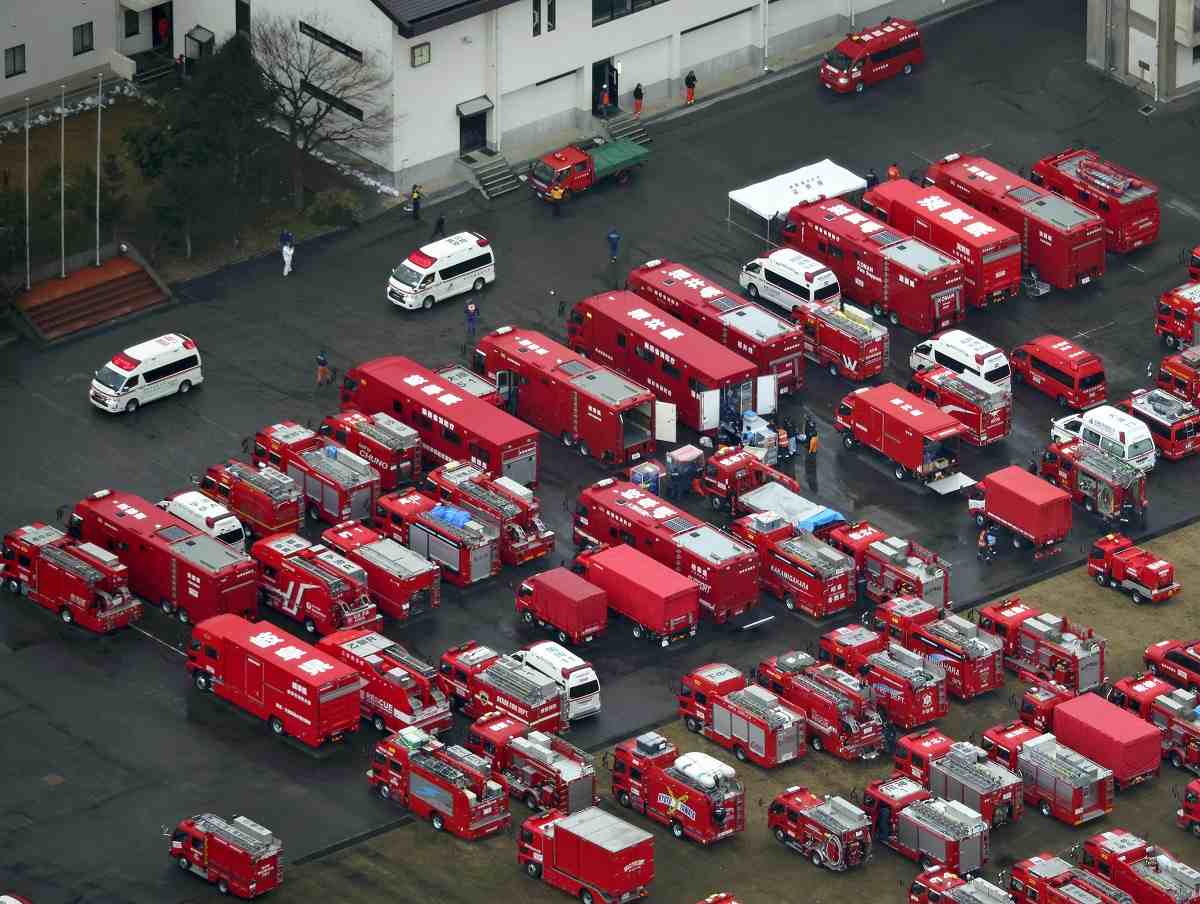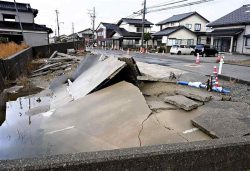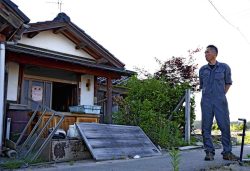Noto Quake — A Closer Look / Local Rescue Workers Spread Thin Over Vast Quake-Hit Area; Firefighter Recalls Desperate Scene at Collapsed House

Rescuers work in Suzu, Ishikawa Prefecture, on Wednesday.
2:00 JST, February 2, 2024
Thursday marked one month since the Jan. 1 Noto Peninsula Earthquake killed more than 230 people and devastated livelihoods and industries in the region. Many people have been forced to live in shelters, and the repair of infrastructure is still in progress. This series examines issues that have emerged in the disaster-stricken areas.
***
A house standing near the coast in Suzu, Ishikawa Prefecture, was wrecked above the first floor. A few hours after the earthquake and subsequent tsunami, local volunteer firefighter Hiroshi Ishii, 57, made his way through the debris to get inside and called out loudly for the man who lived there — who was a senior member of the volunteer fire corps.
“I’m here.” Ishii heard a familiar voice. “I can’t move, my legs are trapped.”
As Ishii moved in the direction from which he heard the voice, he saw his senior colleague’s face. The two men were only one meter apart, but the wrecked house frame and other debris hampered Ishii’s attempts to get closer.
“You should not die until you meet your grandson’s wife!” Ishii encouraged him in a loud voice. But the man’s responses were fading. The tsunami had left him soaked, and the nearly zero C cold seemed to be draining away his body heat. Ishii said he wanted to warm him up as much as possible. He returned to an evacuation center on higher ground to get blankets and water.
The volunteer fire corps, made up of local residents who do not work out of a firehouse as professional firefighters do, did not have enough manpower or equipment to handle such a massive disaster.
“We can’t help him on our own,” Ishii thought. He tried to call the local professional fire station, but was unable to get through. Meanwhile, calls for help came in on his cell phone, and he saw fire.
After taking part in the rescue of other people, Ishii hurried back to his senior colleague with other volunteer fire corps members. He cut through the frame of the house with a chainsaw he had pulled out of the fire corps’ now-leaning warehouse. He finally reached out to touch his senior colleague, but the man was dead.
One month has passed since then. The senior colleague had taught Ishii the basics of the fire corps’ activities. The fire corps had only 15 members, which was already short of capacity. In a severe situation with no way to communicate with each other, only a few of them were able to engage in the rescue effort and they could not rely on professional fire stations.
“Even so, wasn’t there anyway to save him?” Ishii is still gripped by a sense of helplessness.
Big needs over wide area
In the affected areas, the search continues for those who are still missing. As of Wednesday, the number of victims confirmed dead in Ishikawa Prefecture was 238. Police autopsies were performed on 222 of them, with 92, or 41%, found to have died from crushing due to house collapses; 49, or 22%, found to have died from suffocation or respiratory failure; 32, or 14%, from hypothermia or freezing to death.
Prof. Hajime Mizukami of Kanazawa Medical University, 53, was dispatched by the Japanese Society of Legal Medicine to examine the bodies. He believes that “many people died due to a drop in body temperature because they could not be rescued in time.”
The fire department also faced difficulties. The chief of the Suzu Fire Department, 58, recalls, “We tried our best to save the lives we could, but we did not have enough people or equipment.”
On the day of the earthquake, the station received more than 50 calls for help. However, more than 30% of the station’s 39 firefighters, including those at branch offices, were unable to respond. The station had only one vehicle equipped with an electric cutter and other rescue equipment, and it was all they could do to rescue three people from a collapsed house within 24 hours of the quake.
Prof. Shozo Nagata of Kansai University, a specialist in firefighting service administration, who conducted on-site investigations, said, “The lack of firefighting capability in depopulated areas was exposed.”
There were a total of 166 professional firefighters in the vast Okunoto area, which covers about 1,100 square kilometers. Because villages are scattered along the coast, the firefighters are widely dispersed. Therefore, in the event of a disaster, a total of about 1,000 members from 50 volunteer fire corps in the area are the mainstay of the response.
However, due to the aging of the population, there is a shortage of new members, and the number of volunteer firefighters in Suzu had dwindled to 225, down 10% from 10 years ago. In one volunteer fire corps, about one-third of the members are city employees. Nagata said, “In times of disaster, it is important to be able to quickly gather and deploy personnel, equipment, and materials from a wide area.”

"Society" POPULAR ARTICLE
-

M4.9 Earthquake Hits Tokyo, Neighboring Prefectures
-

M7.5 Earthquake Hits Northern Japan; Tsunami Waves Observed in Hokkaido, Aomori and Iwate Prefectures
-

Israeli Tourists Refused Accommodation at Hotel in Japan’s Nagano Pref., Prompting Protest by Israeli Embassy and Probe by Prefecture
-

Tsukiji Market Urges Tourists to Avoid Visiting in Year-End
-

M5.7 Earthquake Hits Japan’s Kumamoto Pref., Measuring Upper 5 Intensity, No Tsunami Expected
JN ACCESS RANKING
-

Keidanren Chairman Yoshinobu Tsutsui Visits Kashiwazaki-Kariwa Nuclear Power Plant; Inspects New Emergency Safety System
-

Imports of Rare Earths from China Facing Delays, May Be Caused by Deterioration of Japan-China Relations
-

University of Tokyo Professor Discusses Japanese Economic Security in Interview Ahead of Forum
-

Japan Pulls out of Vietnam Nuclear Project, Complicating Hanoi’s Power Plans
-

Govt Aims to Expand NISA Program Lineup, Abolish Age Restriction





















